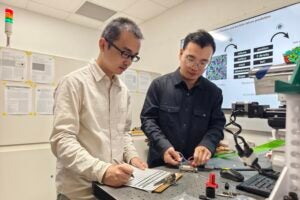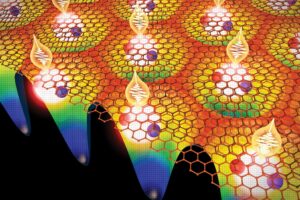Many geoscientists get into the field through a love of the outdoors and a chance to escape the city. But for Danielle Zaleski, cities are where some of the most interesting — and important — questions in geosciences originate. That includes her research on the buildup of microplastics in the sediment of Lake Austin and Lady Bird Lake, both just a couple of miles from The University of Texas at Austin campus.
“When I saw an advertisement about researching microplastics in Austin’s waterways, that was immediately eye-catching,” said Zaleski, who graduated in May with a Bachelor of Science in geology from the UT Jackson School of Geosciences. “It had the urban aspect that I liked, along with the geology and the environmental work.”

Working with Cornel Olariu, a research associate professor in the Department of Earth and Planetary Sciences, and Marcy Davis, an engineering scientist for the Institute for Geophysics, Zaleski has spent the past two-and-a-half years as a student scientist analyzing how microplastics — ranging in size from 45 micrometers to 1 millimeter — have been accumulating in the lakes as the city grows.
Microplastics are everywhere. Scientists have found them on Earth’s highest peaks and in its deepest ocean trenches. So, when Zaleski started filtering microplastics in core samples from the bottom of Lake Austin and Lady Bird Lake, their abundance came as no surprise.
She found them in every section of core pulled from the lake bottoms, with most being “road wear particles” — bits of asphalt binding and synthetic materials from tires.
Her research is helping inform a City of Austin report on the scope of microplastic pollution and what can potentially be done about it. At the same time, it has helped Zaleski grow as a geoscientist and prove herself as a valuable scientist in the lab.
“Give her a small idea, and then suddenly, the next day, it’s double,” Olariu said. “It’s her style to improve and innovate.”
For example, Olariu credits Zaleski with coming up with the method the lab uses to count microplastic particles in lake core samples under the microscope, which can reach into the thousands.
“I told her a few basic things about [the software we use to count the microplastics], but she discovered the method we use herself, and she gave us the way to do it,” he said.
She discovered the method we use herself, and she gave us the way to do it.
For the 2025 Jackson School student research symposium, Zaleski gave a presentation on the microplastics filtered from a 2.84-meter-long core sample from Lady Bird Lake. The core was divided into 20-centimeter intervals, resulting in 15 total samples.

The microplastic accumulation in the core samples reflects the city’s booming growth. The oldest, deepest layers of the nearly 3-meter core have the fewest road wear particles, about 200 per 100 grams of sediment. Samples from the newest, shallowest layers have about 4,600 per 100 grams of sediment.
Zaleski and her advisers are planning to determine the age of the core sediments so the microplastic spikes can be potentially correlated to specific events, such as development or flooding.
Zaleski’s excellence in research has made her a two-time winner of the Jackson School’s student research symposium in the undergraduate category. (The first win was part of a group poster.) This year, Zaleski also won the President’s Student Employee of the Year Award.
Zaleski was selected for the president’s award — often given to students excelling in administrative positions — based on her aptitude as a researcher, said Davis, who nominated her.
“She’s a real self-starter in terms of her science, and she is really good at it,” Davis said.
She’s a real self-starter in terms of her science, and she is really good at it.
Zaleski was drawn to the geosciences — and the Jackson School specifically — after taking an adaptation of the Jackson School’s introductory “Earth, Wind and Fire” course as a senior in high school through UT’s OnRamps program, which enables high schoolers to take popular UT courses for dual credit.
“This is the only place I applied to,” Zaleski said. “My heart was pretty set on it after that class.”
Now, after earning her bachelor’s degree in May, Zaleski will continue her microplastics research at the Jackson School as a master’s student this fall and will expand the scope of her research area to the Texas coast.
She said that while her time in the lab has helped build a host of technical skills that will certainly come in handy during the next stage of her research career, she’s grateful for the host of challenges the school has provided throughout her undergraduate career — from presenting her research, to keeping up in field camp.
“I’ve grown a lot more than I ever would have expected,” Zaleski said. “I am extremely appreciative of the resources provided by the school because I don’t think I ever would have sought out these kinds of experiences if they weren’t presented to me here.”




